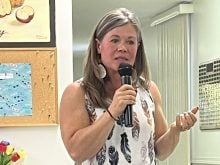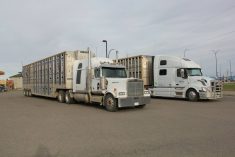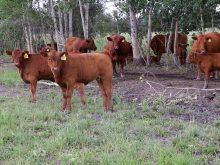BANFF, Alta. Ñ Alberta’s water problems are compounded by the fact most of the province’s residents want to live in the dry south while most of the water is in the sparsely populated north, says a new report commissioned by the Alberta Institute of Agrologists.
In the report, author John Thompson of Watercon Consulting said rather than moving people to the water, the province favours building more storage projects, even though they have their limitations.
“The big projects are done, they are getting more expensive and we are running out of the big fixes,” Thompson told the agrologists’ annual meeting March 31 in Banff.
Read Also

August rain welcome, but offered limited relief
Increased precipitation in August aids farmers prior to harvest in southern prairies of Canada.
There are 27,000 water rights licenses in Alberta and Thompson argued no new licences should be granted to withdraw water from the South Saskatchewan River basin.
No new licences are now available in the Belly, Waterton and St. Mary’s river watersheds, but this does not mean consumption will stop rising because population and industrial demands continue to grow in the region.
Annual water flow from the South Saskatchewan basin varies from 5.3 million cubic decameters to 13.1 million cubic decameters. The average is 9.3 million cubic decameters.
Alberta may withdraw 50 percent of the surface water, which amounts to 4.1 million decameters, but it has allocated 5.6 million decameters through licences for agriculture, industrial, domestic, municipal and recreational use. The province consumes 83 percent of its share, with ground water accounting for about 2.5 percent of what is allocated in the South Saskatchewan basin. This apparent imbalance works because much of what is taken out is returned, especially for domestic use.
“If it were not for return flow and non-use of existing licenses, we could be exceeding that now,” Thompson said.
A municipality probably consumes only 15 percent of what it takes out and the rest is returned through sewage treatment. Most withdrawals for crop irrigation are not returned.
Further, no one is sure how much should be left behind to ensure the health of aquatic systems. A healthy stream needs about 85 percent of its in-stream flow to remain healthy and sustain aquatic life, said assistant deputy environment minister Peter Watson.
“Most of our major rivers are declining in terms of aquatic health,” he said. “We’ve made choices in the past and we are starting to recognize we are living with the consequences.”
The government hopes the water strategy it released last year can address conservation and quality issues.
Watson also said new allocations for the southern basin are unlikely, which means efficiency must be improved rather than trying to divert water from one end of the province to the other.
Moving water from north to south has been discussed since the 1960s, but the Water Act of 1996 prohibits interbasin water transfer.
However, Thompson said that could be revisited.
“This concept of interbasin transfer of water is still alive in some ways.”
Disallowing water transfers from one basin to another prevents exports of water to the United States, unless authority is granted through a special act of the legislature.
This does not apply to bottled or municipal water. For example, Sweet Grass, Montana, receives its water from Coutts, Alta., at the border crossing.
People have the right to transfer water licences and move water in a basin as long as it has no adverse effect on the environment or other users.
A major transfer would require an environmental impact assessment and public hearing.
Water sharing is also allowed and in 2001 when southern Alberta irrigation reservoirs were nearly dry, farmers agreed to share the available supply rather than cut someone off and risk crop failure.
Thompson said the new reality is southern residents must learn to live with what is available within their own river basins.
“Supply management will continue to have a role but we need people to start thinking in terms of demand management.”
Lawyer Russell Carr said it is time the province made tough decisions about allocation and water uses, potentially pushing urban interests into a collision course with agriculture.
“The same pail of water can’t water the golf course, wash the car and irrigate crops,” he said.
Some of those future decisions could mean a water tax that would not only cover delivery and water works costs, but also charge people for consumption.
Thompson said charging for water could prevent investment because companies go where water is cheapest.
Charging agriculture for water is defeatist because farmers have no one to pass the cost on to if they must pay an extra tax, he added.
Thompson said it is more reasonable to mandate low-flow toilets and fix leaky pipes rather than install water meters.
He said the province is investing more in the next four to five years to measure the quality and quantity of Alberta’s surface and ground water.
A water use reporting system for this summer will be set up among major license holders so the government can assess how much was used.















